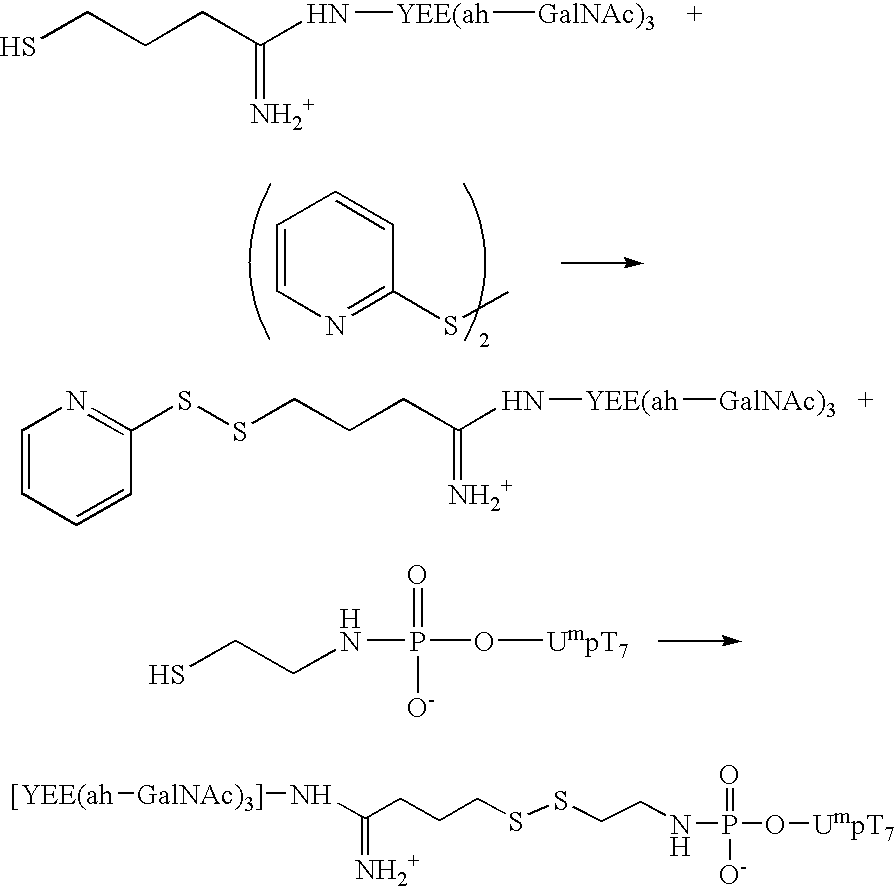Ligands to enhance cellular uptake of biomolecules
a biomolecule and ligand technology, applied in the direction of peptides, drug compositions, peptide sources, etc., can solve the problems of high liver failure, no known efficacy treatment against hcc, and association of hbv, so as to efficiently cross the hepatocyte membrane and gain access to the cytoplasm
- Summary
- Abstract
- Description
- Claims
- Application Information
AI Technical Summary
Benefits of technology
Problems solved by technology
Method used
Image
Examples
example 1
Synthesis of an A-L-P Conjugate [YEE(ah-GalNAc)3]-SMCC-AET-pUmpT7 (10) Using Conjugation Method 1
[0111] Materials: Methylphosphonamidite synthons were a generous gift from JBL Scientific, Inc., and are commercially available. They can readily synthesized from the nucleoside according to established procedures by an ordinarily skilled practitioner. All other reagents for the automated synthesis of UmpT7 (FIG. 3) were purchased from Glen Research, Inc. HiTrap Q anion exchange columns were purchased from Pharmacia LKB Biotechnology. Reverse phase high performance liquid chromatography was carried out using Microsorb C-18 column purchased from Rainin Instrument Co., Inc. Cystamine hydrochloride, 1-ethyl-3-[3-(dimethylamino)propyl]carbodiimide (EDAC), 1-methylimidazole, and anhydrous dimethylsulfoxide (DMSO), dithiothreitol (DTT), and Ellmen's reagent were purchased from Aldrich and were used without further purification. Diisopropylethylamime (DIPEA) was purchased from Aldrich and was ...
example 2
Synthesis of A-L-P Conjugate 1c Using Conjugation Method
[0118] This example describes the detailed procedures for using the Conjugation Method 2 in the synthesis of A-L-P conjugates from a novel type of oligonucleotide analogs, the 2′-O-methyl ribose alternating methyl-phosphonate-phosphodiester backbone. Table 5 listed three oligomers of this type (oligomers 1-3), and their A-L-P conjugates formed with the liver ligand YEE(ah-GalNAc)3 (conjugate 1c, 2c, 3c). The following describes procedures for the synthesis of conjugate 1c. The other two conjugates were synthesized similarly.
[0119] The procedures for using Conjugation Method 2 in the synthesis of 1c involves the following steps: 1) Synthesis of SMCC-YEE(ah-GalNAc)3 (8); 2) Designing of Oligomer Construct 1b; 3) Solid-phase synthesis of oligomer construct 1b; and 4) Conjugation of 1b with SMCC-YEE(ah-GalNAc)3-synthesis of 1c. 5) 32P Radiolabeling of conjugate 1c.
TABLE 5Oligonucleotide Alternating Methylphosphonate Analogs.Seq...
example 3
Synthesis of A-L-P Conjugates-NG1 to NG5 Using Conjugation Method 2
[0129] The conjugation Method 2, as described in Example 2 in this invention, is a general method that can be used to form A-L-P conjugates of any oligonucleotide analogs. The following description is another example to use the conjugation Method 2 for the synthesis of a different type of A-L-P conjugates. In this example, the oligonucleotide analogs to be conjugated belong to the type of oligodeoxyribonucleoside phosphorothioates, one of the major types of analogs used in current antisense drug development worldwide. Because oligodeoxyribonucleoside phosphorothioates are easily labeled at the 3′-end by classical 3′-enzymatic labeling procedures, the 3′-tracer unit, as was used in example 2, is not needed here for the conjugates to be radiolabeled. Therefore, the oligomer constructs to be designed contain only two portions, the phosphorothioate oligomer portion and the 5′-disulfide linker portion.
[0130] These 5′-di...
PUM
| Property | Measurement | Unit |
|---|---|---|
| time | aaaaa | aaaaa |
| molecular weight | aaaaa | aaaaa |
| molecular weight | aaaaa | aaaaa |
Abstract
Description
Claims
Application Information
 Login to View More
Login to View More - R&D
- Intellectual Property
- Life Sciences
- Materials
- Tech Scout
- Unparalleled Data Quality
- Higher Quality Content
- 60% Fewer Hallucinations
Browse by: Latest US Patents, China's latest patents, Technical Efficacy Thesaurus, Application Domain, Technology Topic, Popular Technical Reports.
© 2025 PatSnap. All rights reserved.Legal|Privacy policy|Modern Slavery Act Transparency Statement|Sitemap|About US| Contact US: help@patsnap.com



